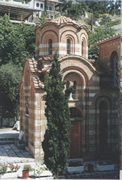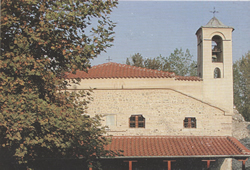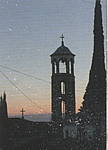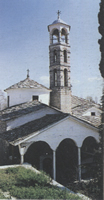THE CHAPEL OF THE SAINT KALLISTOS, PATRIARCH IN CONSTANTINOPLE
Entering the Church of the Agion Theodoron by its main entrance, the chapel of Saint Kallistos, Patriarch in Constantinople, is to your left. Saint Kallistos was born at the end of the Thirteenth Century. After a thorough, wide-ranging education he became a monk on Mount Athos, and was ordained as a priest in the Magoulas Hermitage. It was as representative of the Iberite Monastery that in 1342 he took part in a Peace Mission aimed at reconciling Ioannis Palaiologos and Ioannis Kantakouzinos. He played a leading role in the fight against the Bogomil Heresy, and was made Ecumenical Patriarch after the death of Patriarch Isidoros in 1350. He was removed from the Patriarchal Throne in 1353, but returned to it once more in 1355. He visited Serres in 1364 as the ambassador of Ioannis Palaiologos, the Byzantine Emperor, to the Serbs; his mission to form an alliance to bring the Turks’ advance to a stop. However, a sudden illness led to his death and burial in the city. He was buried in Serres Cathedral with every honour. He was later canonised by the Orthodox Church, his feast being celebrated on June 20.
AGIOS NIKOLAOS
The chapel of Saint Nikolaos is one of two built within the curtain wall of Serres Castle. The second – the ruins of which were remarked upon by the French Franciscan friar, Robert de Dreux, in 1669 – was a dependency of the Holy Monastery of the Timios Prodromos, and was dedicated to the Annunciation of the Virgin. The church of Agios Nikolaos is itself first recorded between 1339 and 1342. In 1688, Evligia Tselebi, the Turkish traveller, writes of the existence of but a single dilapidated church within Serres Castle; and in 1814, Cousinery, the French Consul, mentions the derelict church of Agios Nikolaos and the remains of its frescoes in his travel notes. Architecturally speaking, the church is of a three-niche, single-aisled, domed design, and was built in 1339.
The church was rebuilt, perhaps in a slightly different form from the original, by Lazarus Fotiadis, the master builder, and his son Cyrillos. Work began in 1935 and was completed in 1948. Michalis Katsikostas, the iconographer, immediately set to work decorating its dome and painting the church’s main picture of the Virgin. The rest of the church was worked on by the distinguished iconographers G. Paralis and D. Kentakis in 1956. The church’s wall paintings are copies of those in the Protasis of the Ossios Loukas on Mount Athos and the Daphni Monastery in Attica. The church’s forecourt is used to host various cultural events during the summer months.
THE CHURCH OF THE TIMIOS PRODROMOS THE “PRODROMOUDI”
A dependency of the Monastery of the same name on Mount Menoikios, the church of the Timios Prodromos – the “Prodromoudi” – is one of the most devotion-inspiring churches in the city. Konstantinos Choleviaris, the builder of the church, made it over to the Monastery of the Timios Prodromos to be its dependency when he was elected its abbot. The church was thoroughly renovated in 1819 by two monks from the Timios Prodromos of Menoikios, Silvestros and Kallinikos Kovatseoglou.
AGIOS GEORGIOS THE KREONERITIS
East of Serres lies a monastic dependency of the Monastery of the Timios Prodromos in memory of Saint George, known as the “Krioneritis”. The small church is mentioned for the first time in 1318 in a golden bull issued by the Emperor Andronikos the Elder: “Its builders founded it from the beginning at their own expense and through their own efforts, a small church in the name of the glorious saint and great martyr Georgios, who was called Krioneritis”.
Ipomoni, the nun, handed over the property and fealty of the dependency to the Monastery of the Timios Prodromos in July 1339. In a golden bull issued by King Stefan Dousan of Serbia in 1346, the Krioneritis dependency is recorded as a dependency of the Monastery of the Philotheou. The church was completely destroyed by the Turks in 1571. It remained in ruins until 1862, when Theodosios, the abbot of the Monastery of the Timios Prodromos, succeeded in having a firman issued for its repair. A bell-tower – now the oldest in the city of Serres - was added by Charitonas, the Bishop of Dafnousia. The building houses two churches: the smaller – at the northern end – is dedicated to the glory of Agios Dimitrios; while the larger church to the south is in honour of Agios Georgios. It is known as the “Krioneritis” (of the cold water) due to the cold water in the well that used to stand in its forecourt. There are two exceptional hagiographic works in the church: the Virgin and Child and Christ the Pantokrator.
Writer:
Haralampos Vouroutzidis





